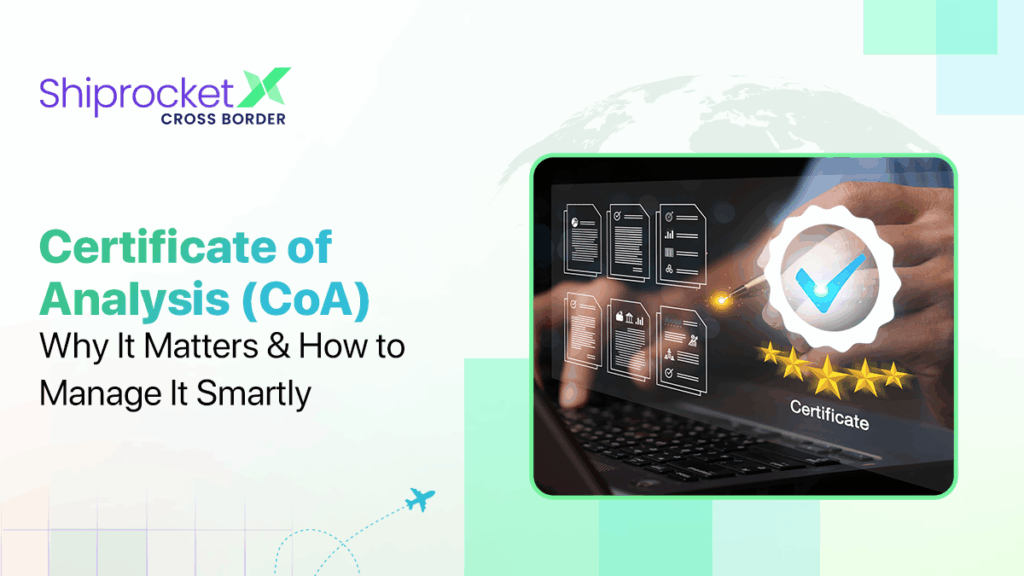Certificate of Analysis: Importance, Uses & Management
A Certificate of Analysis (COA) might sound like paperwork, but for manufacturing, pharmaceuticals, cosmetics, food, and export businesses, it’s more than just a formality. The certificate gives clear, documented proof that a product or material meets the set quality and safety standards. From ingredient checks to export documentation, COA protects businesses and customers by verifying that what’s inside a product matches the label.
Customer satisfaction is about 53% affected by product quality and 47% by other variables. So, you must take a deeper look at why this document holds so much weight in many industries and how to easily get a certificate of analysis (COA) without drowning in paperwork or losing track of what’s been approved.

The Key Elements of a COA Explained
A Certificate of Analysis usually comes from a supplier or manufacturer and goes to the buyer. It outlines the specific testing results of a product or batch, usually matched against a predefined standard or specification. Though COAs can differ depending on the product type and industry, most contain a few core parts.
- Product identification: This includes the product name, lot or batch number, and any other relevant identifiers to match the sample with the test results.
- Testing parameters: These parameters list what was tested (e.g. pH level, purity, microbial limits, heavy metals, etc.) and which methods were used.
- Specifications: These show the required range or limits that the product must comply with.
- Actual results: This section displays what the testing outcome is and if the product passes the check.
- Sign-off: An authorised person in the lab or quality team signs and puts a date on the COA.
In food, for example, a Certificate of Analysis Food Report might include allergen tests, nutrient levels, or shelf-life checks. In pharma, it could show potency, contaminants, and uniformity. The format can be slightly different in various cases, but the purpose remains the same; proof that quality checks were done and passed.
Use Cases for COAs Across Industries
You’ll find COAs used in many sectors, and each industry has its reasons for needing them.
Pharmaceuticals rely on COAs to confirm drug safety, strength, and purity before batches are released to the public. Given the strict regulatory rules in place, a missing or incomplete COA can delay production or shipment.
Food manufacturers need them to confirm that ingredients match the required nutrition levels and comply with food safety rules. For example, a food producer buying raw spices would expect a COA that checks for microbial load, pesticide residues, and foreign matter.
In the chemical industry, COAs are required to validate concentrations and identify any impurities that could affect the product quality.
Cosmetics usually include COAs to prove that the products are free from banned substances, have been tested for irritation, and satisfy labelling claims.
If you’re dealing with exports, a Certificate of Analysis for export may be legally required in some countries. It helps show that products live up to destination market standards, making customs clearance smoother.
Why COAs are a Must for Your Company?
Whether you are a manufacturer, a distributor, or a reseller, COAs help you avoid costly mistakes and strengthen your quality control systems. Let’s look at a few reasons to treat COAs as a priority.
1. Trust and Transparency
Your buyers or clients need confidence that what you’re selling is safe and reliable. The quality of a product has a huge impact on a customer’s trust, which accounts for about 16.4% of the total. Also, about 74% of buyers say that product quality is of utmost importance in keeping them loyal to a brand.
A Certificate of Analysis confirms that a product has been tested and meets required standards before it is made available for sale.
2. Legal and Regulatory Compliance
Authorities like the FDA require COAS in some industries. According to FDA requirements for certificates of analysis, drugs and certain food products must be tested and the results documented. Your shipment can be held or rejected if these aren’t in place.
3. Risk Management
A Certificate of Analysis can be part of your defence if something’s wrong, like a product recall. It shows you did your checks and followed the rules. Lack of documentation can put you in serious financial and legal trouble.
4. Streamlining Audits
In the scenario of an internal check or a visit from a regulator, presenting well-organised COAs shows your systems are in good shape. It can reduce the time spent on company audits and help you maintain certifications or licences.
5. Faster Customs Clearance
If you’re exporting, especially food, chemicals, or pharmaceuticals, customs may ask for COAs. Having them ready and in the correct format saves you from unnecessary delays and extra inspection fees.
Smart Tools and Tips for Managing COAs
It can be quite overwhelming to keep track of Certificates of Analysis, especially if your company manages too many batches, suppliers, or SKUs. Manually storing PDFs or paper files in folders may work for a while, until one important document goes missing or an audit looms.
So, here are some practical ways to keep these things in order:
Digital COA Management Systems
It definitely helps to use a document control or quality management system to track COAs by product, supplier, and date. These systems mostly have features that allow you to set reminders for document reviews and even automate the collection of COAs from suppliers.
For example, some firms use tools that generate automated requests when an order is placed, asking suppliers to upload the latest COA. This helps avoid the follow-up emails and missed paperwork.
Link COAs to Inventory Batches
If you’re using an inventory or ERP software, try linking each batch or lot to its Certificate of Analysis. That way, if a question comes up about a specific delivery, you’ll find the right and relevant document in no time.
Make COAs Part of Supplier Onboarding
When you’re working with new suppliers, include COA submission as a basic requirement. Ask them upfront how to get a Certificate of Analysis (COA) for the materials they supply. Make it clear that you won’t accept any shipments without a valid COA.
Standardise Formats
It would be best to ask your suppliers to follow a standard format for their COAs. Doing so saves time when you review the certificates, helps spot errors early, and also avoids back-and-forth clarification.
Train Your Teams
Make sure your staff knows what to look for in a Certificate of Analysis and where to store them. Even if you have software in place, people are still key to finding errors, keeping data current, and following up when something’s missing.
Backup and Access
You must always keep backups of digital COAs, preferably on secure cloud systems. Make sure the main staff, which is in quality control, compliance, purchasing have easy access to these documents when needed.
How ShiprocketX Supports Easy Document Handling for Exporters
If you’re exporting products, keeping documents like the Certificate of Analysis ready and error-free is just one part of the puzzle. ShiprocketX helps simplify international shipping for you by offering a platform that brings together courier options, customs guidance, and real-time document tracking in one place.
It means you can manage requirements like COAs and other compliance paperwork with fewer delays. Our AI-powered platform also gives you updates on clearance stages and delivery status. This way, you can reduce the chances of missing a shipment window or getting stuck at customs because of incomplete files.
ShiprocketX makes it easier for sellers to stay organised and focus more on growing their reach in global markets.
Conclusion
A Certificate of Analysis might not grab headlines, but its value is clear in almost every industry. You could be manufacturing food, selling skincare, or shipping medicines across borders, these documents keep your quality checks honest and your supply chain frictionless. Knowing how to get Certificate of Analysis (COA), what to include, and how to store and track them makes day-to-day work easier and protects your business from future issues.
With smarter tools like ShiprocketX now available, there’s no need to bank on paper trails or chase down suppliers for missing files. You can manage COAs with much less hassle, and stay one step ahead of audits, regulators, and customer concerns by setting clear systems and using tech to support your process.






